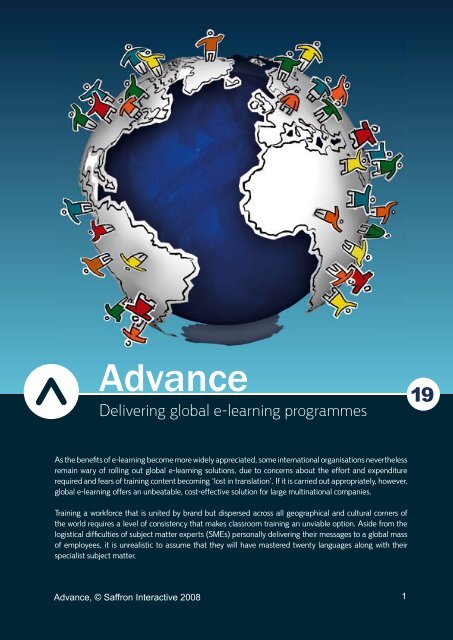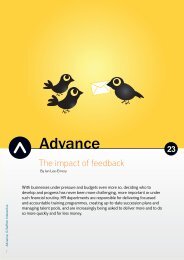19 - Saffron Interactive
19 - Saffron Interactive
19 - Saffron Interactive
- No tags were found...
You also want an ePaper? Increase the reach of your titles
YUMPU automatically turns print PDFs into web optimized ePapers that Google loves.
Delivering global e-learning programmes<strong>19</strong>As the benefi ts of e-learning become more widely appreciated, some international organisations neverthelessremain wary of rolling out global e-learning solutions, due to concerns about the effort and expenditurerequired and fears of training content becoming ‘lost in translation’. If it is carried out appropriately, however,global e-learning offers an unbeatable, cost-effective solution for large multinational companies.Training a workforce that is united by brand but dispersed across all geographical and cultural corners ofthe world requires a level of consistency that makes classroom training an unviable option. Aside from thelogistical diffi culties of subject matter experts (SMEs) personally delivering their messages to a global massof employees, it is unrealistic to assume that they will have mastered twenty languages along with theirspecialist subject matter.Advance, © <strong>Saffron</strong> <strong>Interactive</strong> 20081
with the ability to “rollback” changes if they weren’tcorrect. More than 50 people accessed this serverthroughout the project and it enabled real efficiencies.For example, content might be translated in onecountry while the audio is concurrently being recordedin another country.Global projects such as this also require frequentcommunication in various forms. Team members on thisrecent project used web-conferencing, teleconferencingand file sharing as well as traditional face-to-facemeetings to keep in touch. Being able to recognisewhich form of interaction is required with whomat each stage of the project and maintaining openlines of communication between all team membersencourages trust, respect and confidence in oftencomplex situations.In addition, it is advisable to break the project down intokey deliverables, assigning specific tasks to particulargroups or individuals, and to log this information in adatabase to ensure robust project management. Wherecontributors are geographically spread, this enablesindividuals and small groups to focus upon theirspecific role and deliverables at any given time, servingto support the project team as a whole.Further initiatives can be introduced to enhance thesmooth running of a collaborative effort. For example,in building a recent global programme for HiltonInternational, <strong>Saffron</strong> developed new screen capturesoftware known as i-Capture. The i-Capture toolprovides team members re-working the course content,such as in-house translators, with the defined space intowhich content must fit for the design of the screen towork. Novice users require just a few hours of training,usually over the phone, to become proficient in usingit. In this way, i-Capture enables the course to be rewrittenfor a specific purpose, whilst maintaining aconsistent appearance and functionality.Consistency andstandardisationWith numerous different contributors, there has to bea focus on consistency, particularly for key corporateor service messages that must be uniform around theglobe, regardless of language. Agreeing standardsacross the global team, in all aspects of the project, isalso crucial in making the project labour-efficient andconsistent in style.In <strong>Saffron</strong>’s experience, simple tips that help to deliver aseamless user experience, particularly where translationsare involved, include:• Developing the learning to fit a series of predesignedformats with common graphics, textspace, positioning, logos and so on across theglobe• Agreeing a “standards” manual at the outset,outlining common terms and phrases, and howabbreviations, acronyms, amounts and phonenumbers must be represented, for example. Thismust be updated and shared amongst the teamthroughout the project• Specifying the simplicity and tone of languageto be used• Focusing on including realistic and relevantscenarios and examples that meet the learningneed and have global relevanceWhilst global collaboration is enabled by technology,these measures, based on effective communication anda focus on common goals, are critical in ensuring that theproduct is both consistent and universally usable.You have never neededQA moreWhen done to a high standard, the development ofe-learning will be centred around the need to ensurequality. In a global e-learning project, both informal andformal quality assurance (QA) must be integrated intothe development and translation stages to mitigate theeffects of a large number of contributors.Peer and management review of draft content can helpensure global validity and credibility in the early stages,with formal QA processes guaranteeing output quality.Similarly, translated content should first be peer reviewedwithin the company, with external experts brought in forfinal QA. What’s more, good QA will ensure that thee-learning works first time, every time, in spite of anyregional or country-specific variations in the technicalequipment or communications links available to theuser.A strong QA process is crucial to achieving consistencyof experience and content, which in turn leads to acommon, positive training solution.4 5Advance, © <strong>Saffron</strong> <strong>Interactive</strong> 2008 Advance, © <strong>Saffron</strong> <strong>Interactive</strong> 2008






